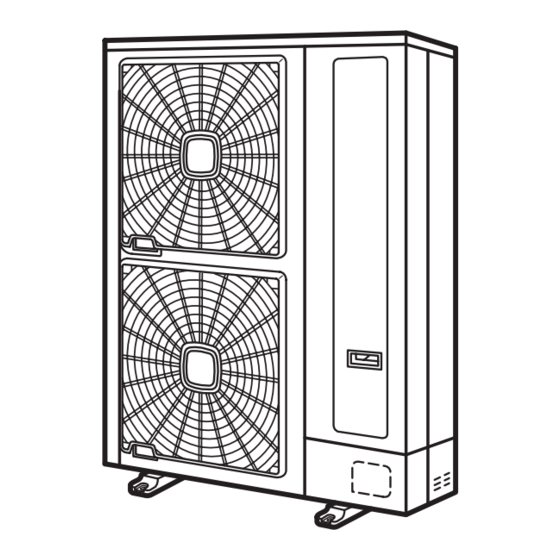Table of Contents
Advertisement
Installation
&
Maintenance
Manual
INVERTER-DRIVEN
SPLIT SYSTEM
HEAT PUMP
AIR CONDITIONERS
- DC INVERTER UTOPIA -
Models:
Outdoor Units;
RAS-3HVRNM2
RAS-4HVRNM2
RAS-5HVRNM2
RAS-6HVRNM2
RAS-7HVRNM2
IMPORTANT:
READ AND UNDERSTAND
THIS MANUAL BEFORE
USING THIS HEAT-PUMP
AIR CONDITIONERS.
KEEP THIS MANUAL FOR
FUTURE REFERENCE.
TC-12001
OUTDOOR UNIT
P5414950
2-73
Advertisement
Table of Contents

Summarization of Contents
Important Unit Installation Notices
Prohibited Installation Locations and Hazards
Lists locations to avoid for installation due to hazards like fire, corrosion, or gas presence.
Electromagnetic Interference and Placement
Advises on installation near medical equipment and electromagnetic sources.
Environmental Considerations for Unit Placement
Cautions regarding plants, animals, and ventilation requirements for outdoor units.
Product Receiving and Inspection Procedures
Shipping Damage Inspection and Claims
Inspect for shipping damage and file claims immediately with the shipping company.
Model and Electrical Specification Verification
Verify model number, electrical characteristics, and accessories for correctness.
Comprehensive Safety Summary
Understanding Hazard Signal Words
Explains signal words (DANGER, WARNING, CAUTION, NOTICE) and their meanings for hazard communication.
Critical Safety Precautions for Installation
Essential safety warnings for installation, refrigerant handling, and power supply connections.
General Warning Guidelines for Safe Operation
Warnings on flammable gases, proper grounding, secure wiring, and foundation integrity.
Cautionary Advice for Unit Handling
Cautions against stepping on the unit, foreign materials, and stresses the importance of secure foundations.
Notices and Notes on Operation
Information on electromagnetic interference, power supply stability, and operational recommendations.
Unit Structure and Component Identification
3HP Outdoor Unit Component Overview
Identifies and lists the parts of the 3HP outdoor unit with a detailed diagram.
4-7HP Outdoor Unit Component Overview
Identifies and lists the parts of the 4-7HP outdoor unit with a detailed diagram.
Essential Installation Tools and Instruments
Lists necessary tools and instruments for installation, including safety notes on refrigerant handling.
Pre-Installation Planning and Guidelines
Unit Model Selection Methodology
Flowchart and steps for selecting appropriate indoor and outdoor unit capacities.
Standard Outdoor-Indoor Unit Combination Chart
Table detailing standard compatibility between outdoor and indoor units.
Guidelines for Enhanced Unit Combinations
Rules for enhanced combinations, capacity ratios, and minimum indoor unit capacity requirements.
Transportation and Handling Procedures
Safe Lifting and Hanging Techniques
Instructions for safe lifting and hanging of the outdoor unit using cranes or handles.
Handling Precautions and Unit Weight Information
Guidelines for unit handling by handles, including weight and center of gravity details.
Outdoor Unit Installation Process
Verification of Factory-Supplied Accessories
List of accessories included with the outdoor unit and their functions.
Critical Initial Installation Checks
Essential pre-installation checks covering ventilation, noise, foundation, and environment.
Optimal Installation Location Criteria
Guidance on selecting suitable installation sites, avoiding hazards like gas, dust, or strong winds.
Drainage Management for Outdoor Units
Instructions for managing drain water, ensuring proper drainage and preventing slip hazards.
Installation Adjustments for Windy Conditions
Advice on placement to mitigate wind effects and the use of optional wind guards.
Required Service Space Clearances
Specifies the necessary clearances around the outdoor unit for operation and maintenance.
Secure Outdoor Unit Mounting and Anchoring
Procedures for securing the unit with anchor bolts and additional fixing arrangements.
Refrigerant Piping Work and Connections
Refrigerant Piping Material Specifications
Requirements for copper pipes, including cleanliness, size selection, and end protection.
Flaring and Jointing Best Practices
Detailed instructions for performing flaring operations and selecting appropriate pipe joints.
Optimizing Refrigerant Pipe Size Selection
Tables and guidelines for selecting correct pipe sizes based on unit capacity and system configurations.
Branch Piping and Length Limitations
Guidance on branch piping, maximum length limits, and managing height differences between units.
Connecting Refrigerant Piping Systems
Procedures for connecting refrigerant piping, including stop valve operation and torque specifications.
Electrical Wiring and Connections
Pre-Wiring Checks and Component Selection
Essential pre-wiring checks, component selection, power supply voltage, and grounding verification.
Outdoor Unit Electrical Wiring Diagram
Detailed instructions and diagrams for connecting electrical wiring to the outdoor unit.
Recommended Wire Sizes and Capacities
Tables specifying recommended wire sizes for power supply and control cables according to standards.
Dip Switch Configuration
Setting DSW2 for Piping Length
Guide for setting DSW2 dip switches based on piping length for optimal system performance.
Configuring Optional Functions via Dip Switches
Instructions on setting various optional functions using dip switches for different operational modes.
Refrigerant Management and Charging
Performing the Air-Tight Test
Step-by-step procedure for conducting an air-tight test on the refrigerant piping system.
Vacuum Pumping and Refrigerant Charging
Guidelines for vacuum pumping and charging additional refrigerant based on piping length.
Calculating Additional Refrigerant Quantity
Method for calculating and charging the correct additional refrigerant quantity for the system.
Refrigerant Concentration Safety Limits
Procedures for calculating and maintaining safe refrigerant concentration levels within occupied spaces.
Test Run and Troubleshooting
Pre-Test Run Safety and System Checks
Essential checks before test run: power, insulation resistance, and valve status.
Executing the System Test Run
Detailed steps for performing the test run using the remote control switch and observing operation.
Interpreting Alarm Codes for Troubleshooting
A guide to understanding alarm codes and their potential causes for issue resolution.
Safety and Control Device Configuration
Compressor Protection Mechanism
Explanation of the high pressure switch and other compressor protection features.
Fan Motor Protection Operation
How fan motor output is adjusted based on thermistor temperature readings.









Need help?
Do you have a question about the RAS-7HVRNM2 and is the answer not in the manual?
Questions and answers